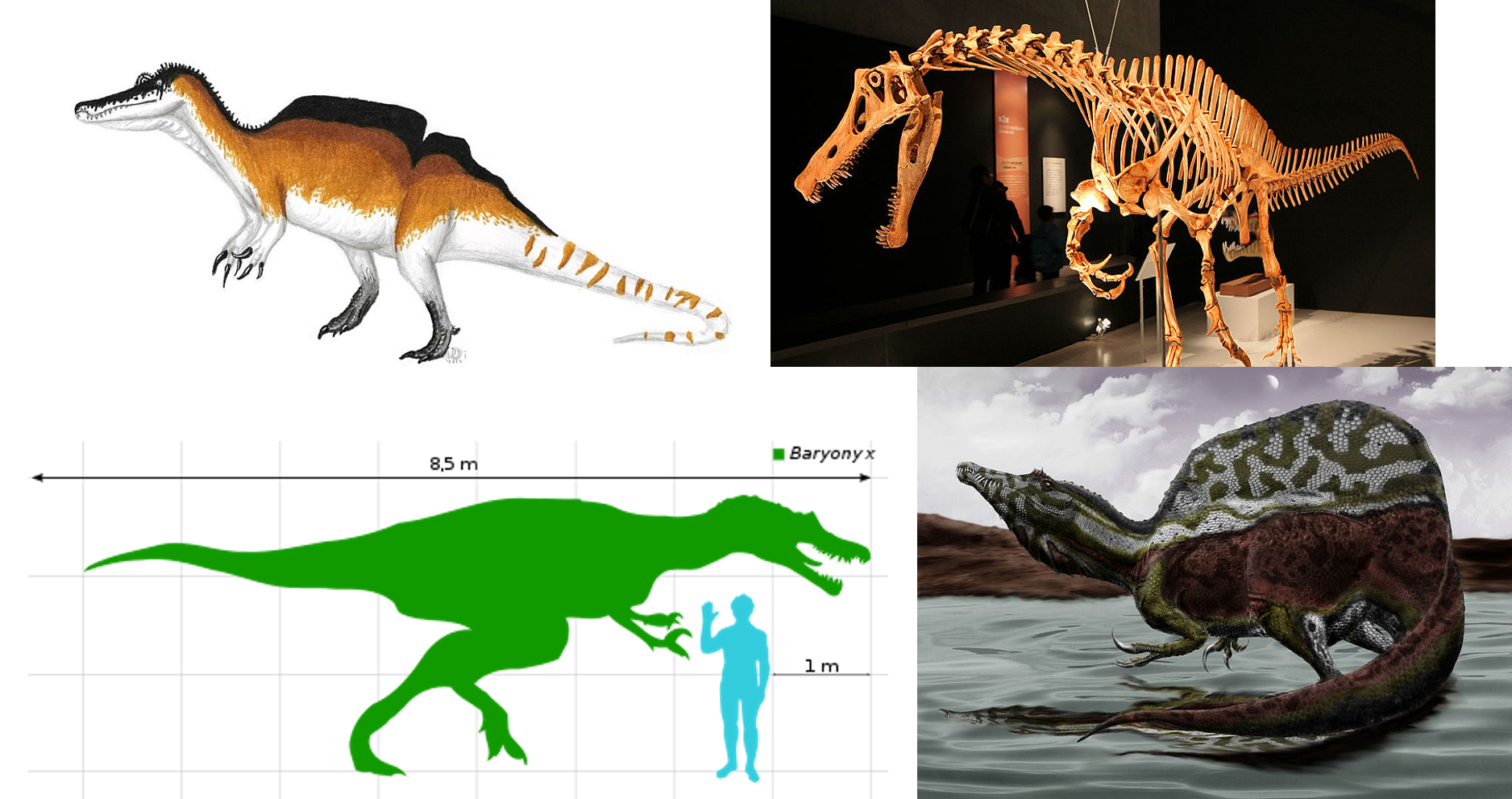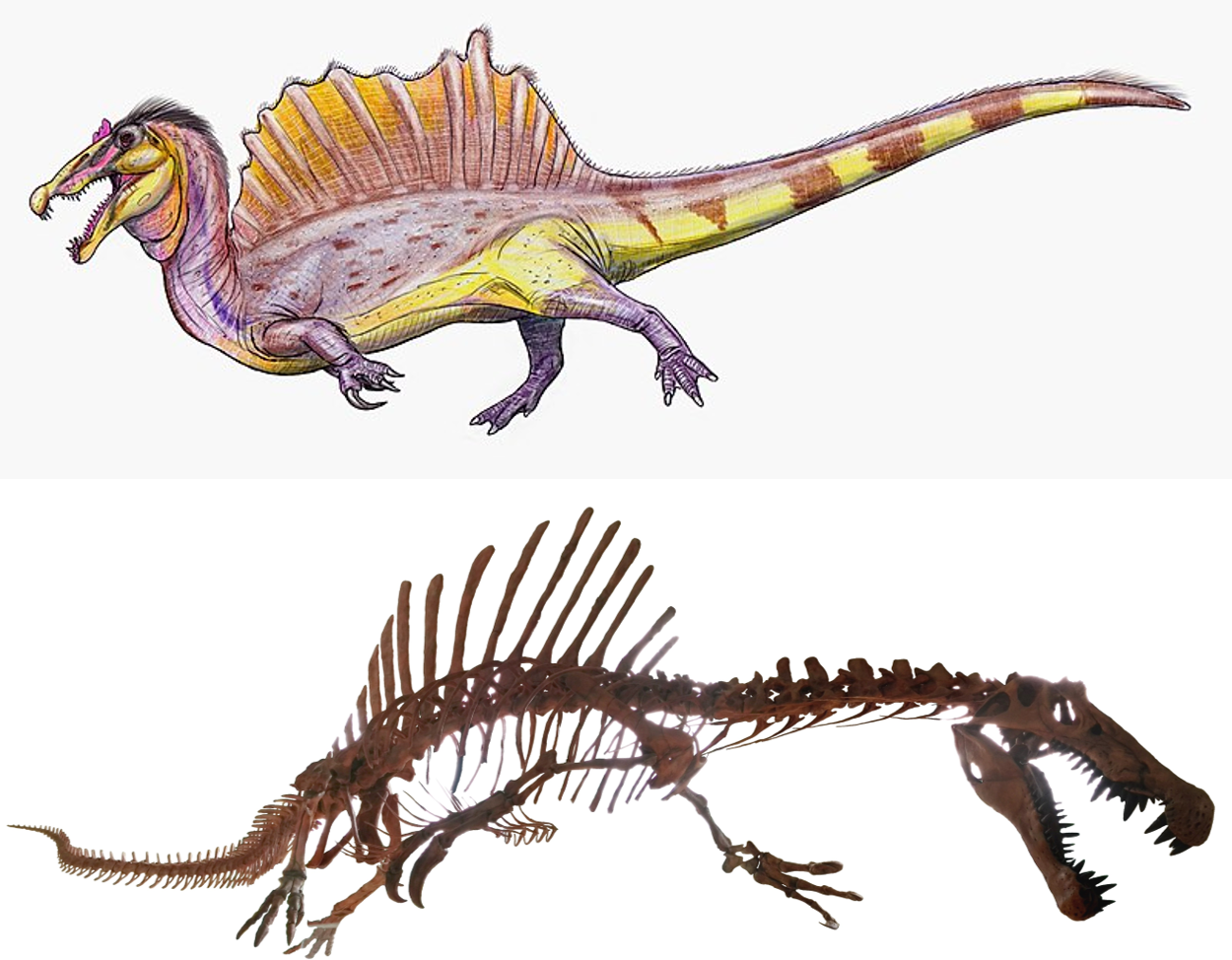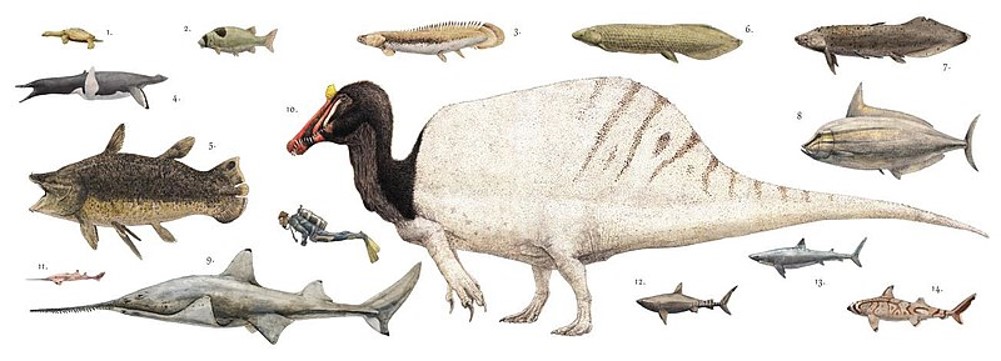Listen to Episode 42 on PodBean, Spotify, YouTube, or a podcast app near you!
This episode we’re back on the subject of dinosaurs! Specifically, a very popular, very bizarre group of theropod dinosaurs known for their croc-like faces, ridiculous ornamentation, and a whole lot of scientific argument: the Spinosaurs.
In the news
Why are salamanders better at regeneration than lizards?
A new species from Utah: the earliest desert-dwelling pterosaur.
These squishy fossils may be true animals from all the way back in the Ediacaran.
We know “griffinflies” were the largest insects ever, but how exactly did they hunt?
Meet the Spinosaurs
The family Spinosauridae is a strange and fascinating branch of the theropod dinosaurs. Like most theropods, spinosaurs stand on two legs (generally), with a long tail in the back, clawed hands up front, and a mouth full of sharp teeth. But a few characters set spinosaurs apart from the rest: long gharial-like snouts; big thumb claws; snout crests; tall vertebral spines; cone-shaped, not-very-serrated teeth; and more. These features paint a picture of dinosaurs with an unusual appearance and an unusual lifestyle.

Spinosaurs are found all over the globe. The famous “heavy-clawed” Baryonyx comes from Europe; the memorably-named Irritator is one of a few spinosaurs known from South America; Ichthyovenator, with its strange “sinusoidal” sail, was the first spinosaur named from Asia; and North Africa is home to lots of spinosaur fossils including Suchomimus and the dinosaur that gave the family its name: Spinosaurus. Most spinosaur remains from the Cretaceous Period, though there are a few remains from the Late Jurassic.
But despite their wide distribution, the spinosaur fossil record isn’t great. Aside from their teeth, spinosaurs are pretty rare, and many of them are only known from bits and pieces. This makes it difficult for paleontologists to answer questions such as: What did they look like? How did they live? How many species are there, exactly? The science of spinosaur-study is loaded with discovery and debate.
Spinosaurus
Spinosaurus has the distinction of being the first recognized spinosaur (named in 1915 by Ernst Freiherr Stromer von Reichenbach – what a name!), perhaps the largest of the family (estimates range from 40-60 feet long), and probably the most controversial. Why controversial? Well, the original Spinosaurus fossils – the holotype material – were completely destroyed during bombing raids in Munich in 1944. Thankfully, Stromer took detailed notes, but still we are left with no physical reference material, making it a challenge to determine which new fossils truly belong to Spinosaurus, and as you can imagine, that makes decoding the lifestyle – or even the shape – of this animal a bit difficult.

Famously, a 2014 study proposed a dramatic change to our image of Spinosaurus. With the help of some newly-discovered fossils, the researchers suggested that this big sail-backed dinosaur, with its small back legs and long body, couldn’t even walk on two legs, and was stuck swimming around Cretaceous waterways. But that’s not the last word – these results have been discussed, debated, and challenged ever since. A newer study from just this month, using biomechanical modeling, argued that Spinosaurus was perfectly competent on two legs, and would have been a poor swimmer. And the debate goes on!

Walking? Wading? Wet?
All this talk – and artwork – about swimming spinosaurs is related to one of the group’s most interesting features: they appear to have been partially aquatic!
Scientists have mused for a long time that spinosaur faces have many of the same features other animals – like crocs and eels – use for catching fish. And indeed, fish scales have been found in the gut of Baryonyx. What’s more, studies have found that spinosaurs have thick, dense bones similar to modern-day aquatic animals, and the chemical signature of their bones and teeth also indicate aquatic habits and fishy foods.
BUT not all signs point to the water. Other spinosaur gut contents include land-lubbing dinosaurs and pterosaurs; not all spinosaur bone chemistry is definitely aquatic; and much of their anatomy looks a lot like other land-dwelling theropods
So, many researchers have suggested spinosaurs were semi-aquatic, capable of moving across land and also hunting in the water. Some have suggested they lived like herons, hunting for fish in the shallows; others say they might have been like grizzly bears, land-living but with a taste for fish; and still others suggest they actually swam after their food. Perhaps, across the spino-spectrum, they did all of the above.

Not enough spinosaurs for you?
Hone and Holtz 2017 is a great (technical) overview of what we know – and what we don’t – about the Spinosauridae.
If you like Spinosaurus, check out this quick history (non-technical) by Nick at Rex Machina.
And for a more detailed (slightly technical) dive into some of the recent debates over Spinosaurus classification and posture, read Mark Witton’s overview.
And if you want even more technical details, here are two recent open-access papers with lots of info and references within: Evers et al 2015 and Henderson 2018.
—
If you enjoyed this topic and want more like it, check out these related episodes:
- Episode 21 – Dinosaurs, an Introduction
- Episode 120 – Tyrannosaurs
- Episode 87 – Ceratopsians (Horned Dinosaurs)
- Episode 101 – Sauropods
We also invite you to follow us on Twitter, Facebook, or Instagram, buy merch at our Zazzle store, join our Discord server, or consider supporting us with a one-time PayPal donation or on Patreon to get bonus recordings and other goodies!
Please feel free to contact us with comments, questions, or topic suggestions, and to rate and review us on iTunes!